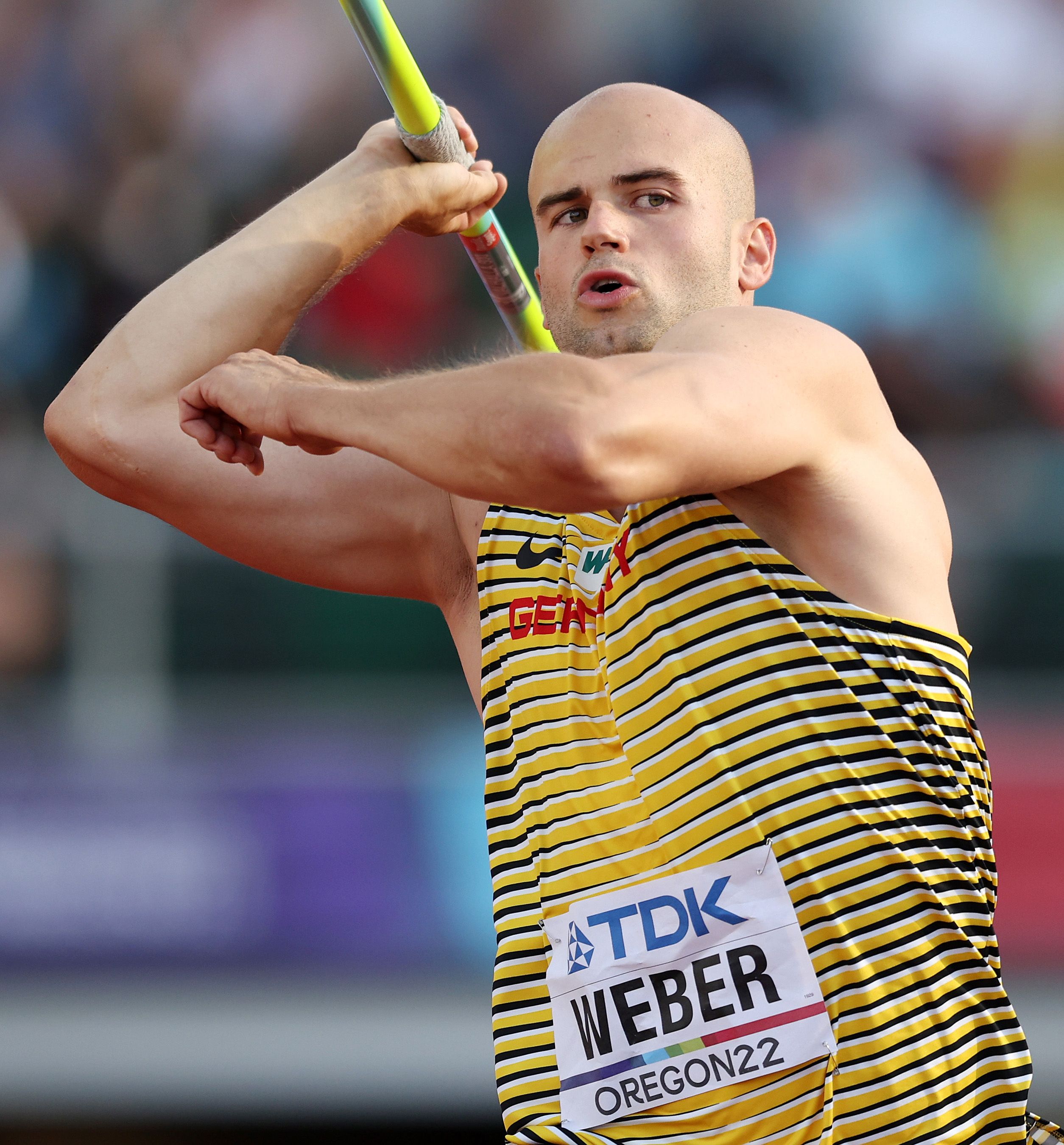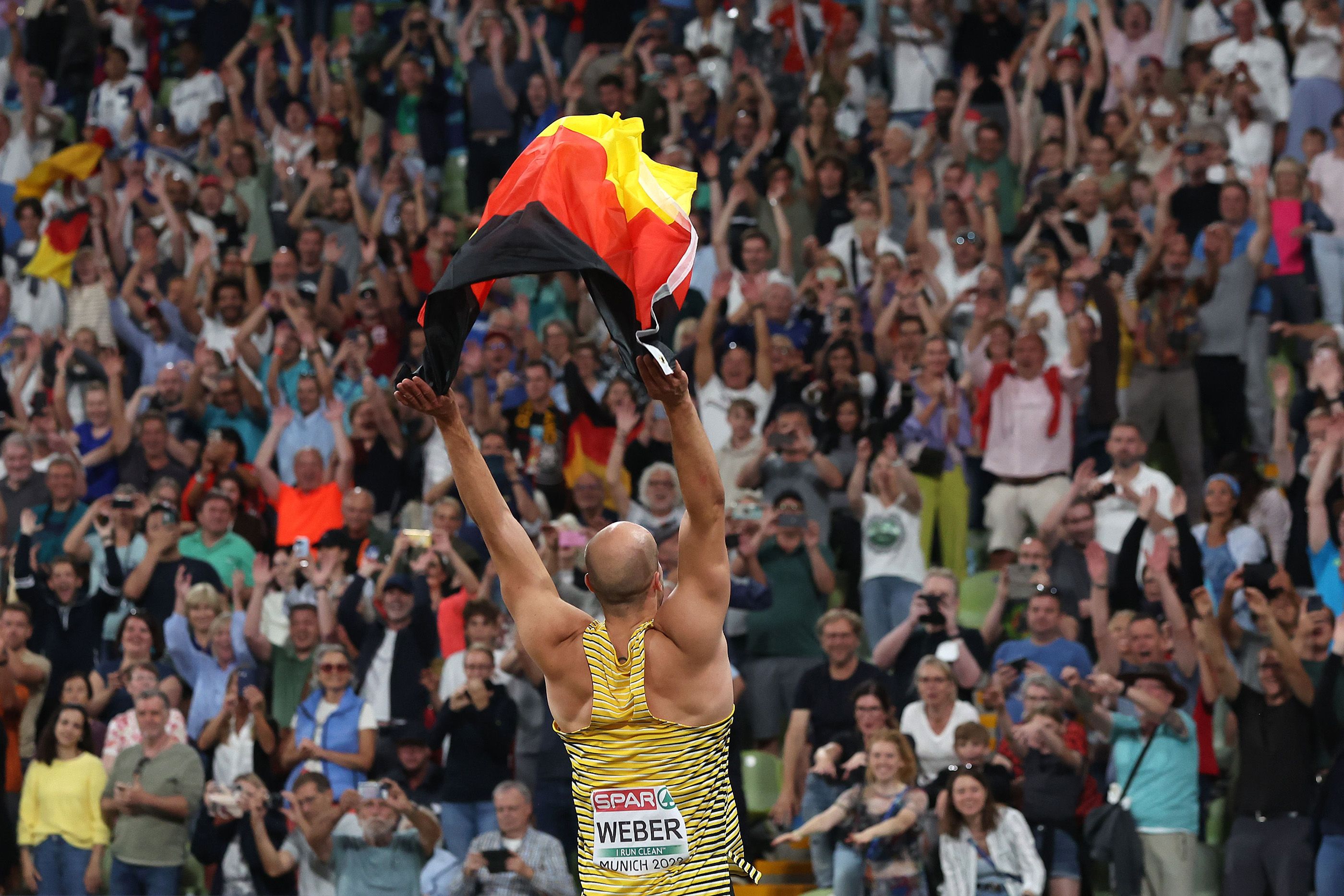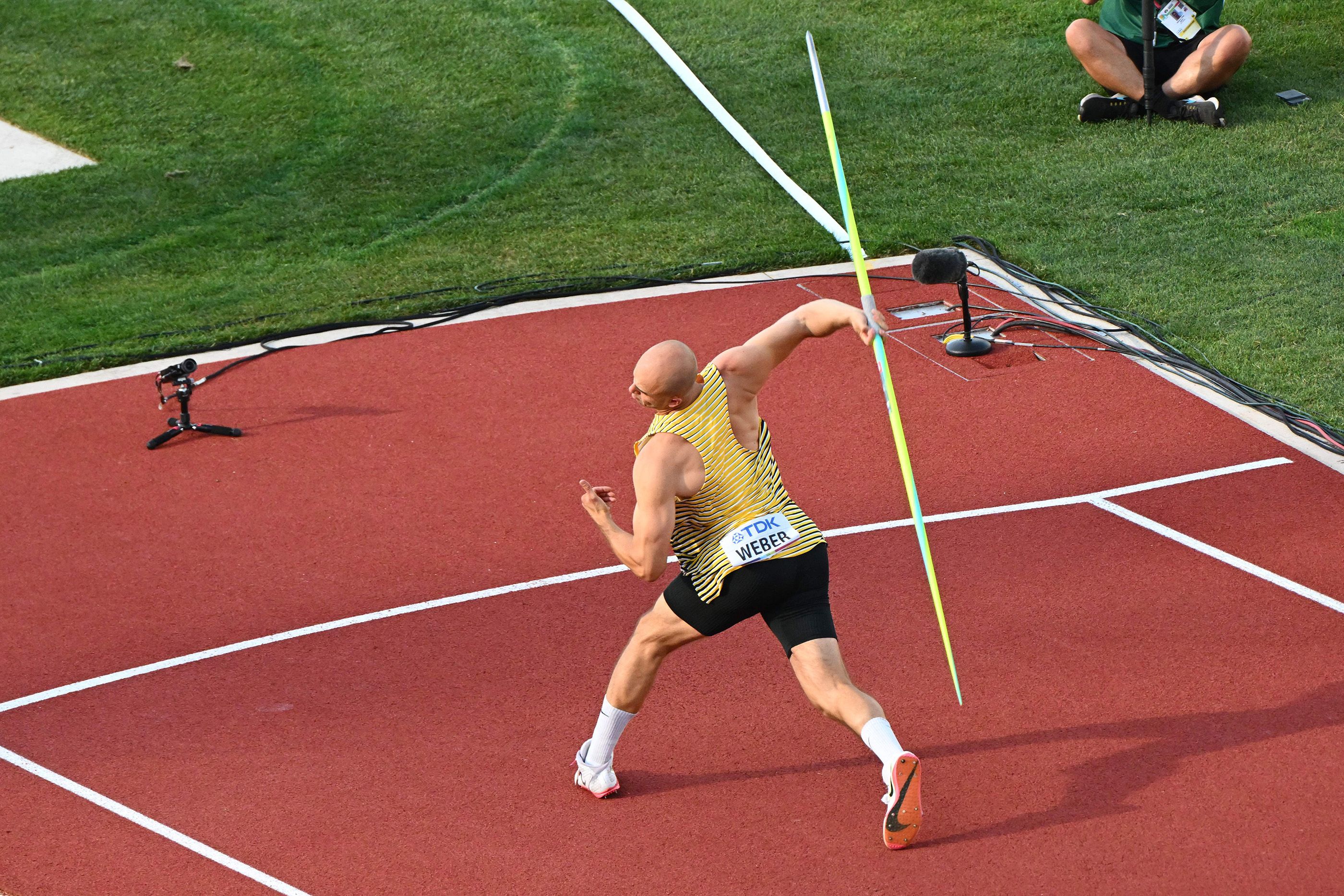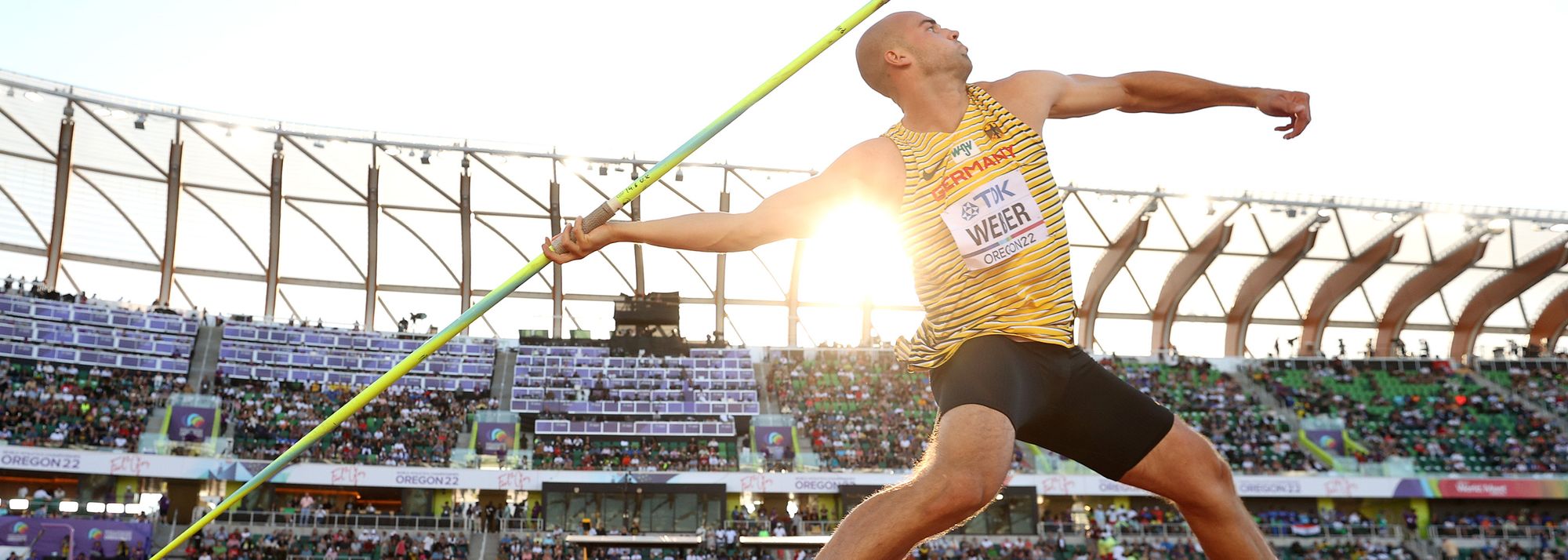Julian Weber competes at the World Athletics Championships Oregon22 (© Getty Images)
It can seep into your mind, your physique, and ultimately your performance. As much as Julian Weber would like to say he’s impervious to pressure, noise and outside criticism, he’s not.
In truth, no athlete is.
Weber is now 28, and it’s 10 years since the German won the European U20 javelin title, throwing 79.68m, the longest throw in the world by an U20 athlete that year. Since then, he’s been in two Olympic finals, two world finals, and has built up a wealth of experience at the sport’s top tier, making him a leading contender for javelin gold at the World Athletics Championships Budapest 23. But all that wisdom and experience makes what happened in Oregon last year all the more unusual.
“That was the first time where I had difficulties with mental things,” he says. “Before, I never had problems. I was always (in) beast mode, competition mode, throwing much farther in competition than training. But this time there was pressure on me. I made it for myself, but also from surroundings.”

Julian Weber in Oregon (© Getty Images)
Germany is a proud, powerful athletics nation, but heading into last year’s World Championships, they had just a small handful of true medal hopes. “The news was (saying) the Germans are not any good at sport, there are not many medals, I felt I was one of the only hopes,” he says.
For Weber, this was a new feeling. Before, he’d always gone into major championships under the radar. But after throwing his PB of 89.54m in Hengelo last June, many assumed he’d deliver a medal on the global stage. He didn’t. Weber launched himself into contention with his first-round effort of 86.86m, but it was one he couldn’t improve, having to settle for fourth in the end – the same place he’d finished in the Tokyo Olympic final.
A month later, he had a shot at redemption, on home turf, at the European Championships. The feeling going into that final at Munich’s Olympic Stadium couldn’t have been more different to Oregon. Weber’s throwing shoulder was badly inflamed, so much that he aborted his warm-up due to the pain. His family was there in the stands but, conscious of his injury, he tried to dampen their expectations.
“I was writing in my family WhatsApp group: ‘Don’t hope for much, I’ll try my best, but I don’t think it will work today.’”
This time, the “mental fight” he faced was not with outside noise, but with his own body.
“I thought, ‘I’ll put everything into that first throw.’ It was such a relief when I saw it was working.” Weber opened with 83.05m, then in the fourth round, in front of a raucous German crowd, he unleashed an 87.66m effort to take command. Minutes later, he was the European champion. What lesson did he learn from Oregon and Munich?
“It's not about avoiding (pressure),” he says. “It’s about accepting it and getting along with that.”

Julian Weber celebrates his European title win on home soil in Munich (© Getty Images)
His talent for throwing was evident from an early age. As a child, handball was Weber’s first love, and these days his brother and sister are both professional players. He was first introduced to athletics alongside them at the age of eight, but stepped away from it when he was 12 to focus on handball. Throughout his youth, teachers and coaches became acutely aware of the ability he possessed in that right arm.
Weber remembers a ball throw competition in elementary school, and how he launched it over the boundary of the field, out into the car park. “My teachers were angry at me because I was throwing too far, hitting the cars,” he says.
Then there was the shot put competition in ninth grade, with students seeing how high they could throw it against the wall, his teacher promising a can of coke for anyone who reached the upper part. “I threw above the wall, through the window,” he laughs. “The teachers were angry at me then – no coke, unfortunately.”
From the age of 12 to 16 Weber focused on handball, but his old athletics coach knew what talent he had for throwing and encouraged him to return to the sport. He threw 52 metres in the javelin that summer without any training, qualifying for a regional youth championship. “Then I got a really good, fast progression,” he says. “Two years later I was European (U20) champion.”

Julian Weber in action at the 2013 European U20 Championships in Rieti (© Getty Images)
At the beginning of that year, 2013, he broke his thumb playing handball, which required a metal implant to stabilise it while it was healing. For throwing, this was a huge problem. Most javelin throwers hold the spear between their thumb and index finger, but within a couple of weeks, Weber discovered a new way to carry on throwing, placing it between his index and middle finger, continuing to throw with his thumb heavily bandaged.
Ten years on, that’s still the grip he uses, and over the years he’s only met one elite thrower, Japan’s Genki Dean, who adopts the same approach.
The road to where he is now has taken Weber to various parts of Germany, and through various coaches. From his home city of Mainz to the Baltic city of Rostock to his current home in Berlin, training just outside the city in Potsdam under the guidance of coach Burkhard Looks.
“It was a long and difficult path, with a lot of injuries,” he says. “The most important thing for me is to get to know my body and what my body needs to perform well. Not always to give 110%. I had to get away from too-hard training. Sometimes I wanted too much.”
Weber endured major issues with the tendons in his left foot over the years, the “blocking” foot he plants while releasing the spear, and he has undergone three surgeries on it. “It’s not that flexible anymore so I have to change the technique to throw without pain so it’s possible to block kinder,” he says. “I had to adapt my technique to my body.”

Julian Weber in action in Oregon (© AFP / Getty Images)
In recent years, he’s had to make major concessions in training and competition, with throwing sessions often requiring “three or four days” of recovery. “I do a lot of regeneration now, taking more care of my body – mobility, stretching, fascia rolling, ice bath, sauna. I do nearly more in regeneration than training.”
The issues plagued him at many key points in recent years. In the Tokyo Olympic final in 2021, Weber’s foot was over-pronating when he planted it due to the injury, taking a slight but critical edge off the force he was able to generate with each throw. He finished fourth with a best of 85.30m, just 14cm away from a medal, two metres shy of gold.
“I knew I could throw farther,” he says. “But fourth at the Olympics; in the first moment I was a little sad, but after I was really happy. But I want more.”
After last year’s Europeans in Munich, Weber allowed his body and mind a chance to reset, taking three months off training. He spent several weeks completing soldier training for his position with the German army, allowing his shoulder to recover, his mind to recharge.
“Maybe I’m a bit late in preparation because of that so I’m building up my power,” he says. “I really focus on the World Championships to get my best potential there. It’s good right now, but I think it can go better with the time of the season.”
What areas can he still improve?
“I’m not the strongest – someone like Johannes Vetter is not double my strength, but kind of,” he laughs. “There’s always a lot to improve. Technique can be better. My strength can be better. What I’m really good in is my throwing shoulder – I have a good, fast, flexible shoulder, and my feeling for javelin throwing.”
Weber displays much of his training on Instagram, from hefty deadlifts to gymnastic handstands to hurdle drills and yoga poses, and then there’s the variety of complex machines he utilises to generate more speed, more force, through his throw.
“I try a lot of things to find new ways to train javelin. I always try to adapt every workout to try to reprogramme new exercises into a more javelin-specific way. It’s a cool way to try something new.”
His goal now is the same as it’s been for several years, though this season it feels more realistic than ever.
“My hope is to go on like last year, throwing far, over 90 metres, and to win some medals,” he says. “That’s the plan.”
Cathal Dennehy for World Athletics












